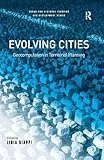Evolving Cities Geocomputation in Territorial Planning
Language: English Publication details: Oxford Routledge 20170302Edition: 1Description: 244 pISBN:- 9781351937979
Geocomputation has come of age. The whirlwind of change experienced in Geographical Information Science (GIS) - developments in IT, and new data gathering and earth observing technologies - has taken GIS beyond mere data and towards its analysis, modeling, and use in problem solving. Geocomputation is now at the dynamic edge of this revolution. Bringing together the leading researchers in geocomputation, this volume provides an up-to-date overview of the development of new artificial intelligence principles and technologies (NN, CA, Multi-agent Systems and Evolutionary Algorithms) used for the analysis, development and evaluation of urban planning policies and programmes. Charting the new approaches to data-processing, the book provides pointers on how to harness these technologies, advancing the knowledge level of planning by multiplying the information capacity of GIS, and offering a new approach to territorial modeling and micro-scale descriptions of socio-economic, behavioural and micro-spatial theories of urban processes and land use change.
There are no comments on this title.
